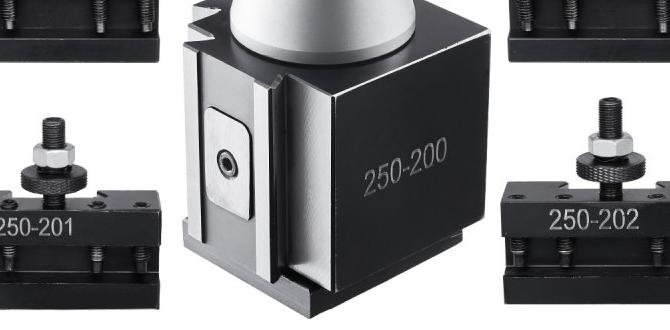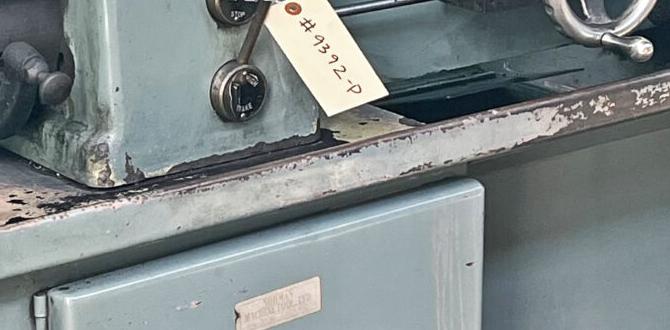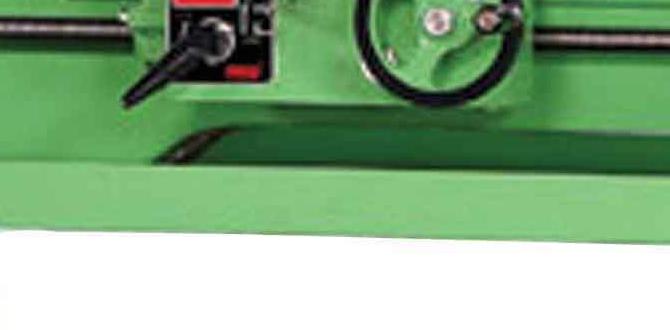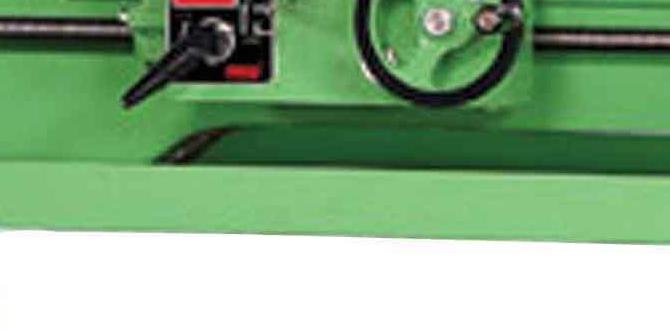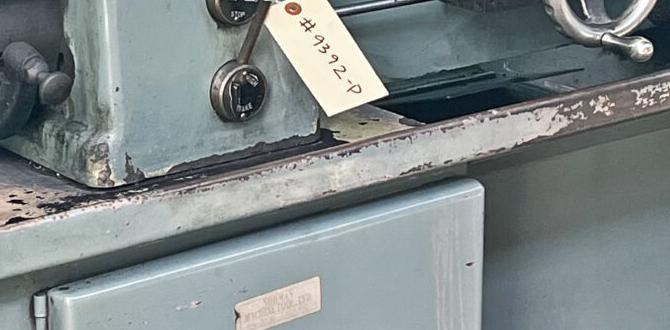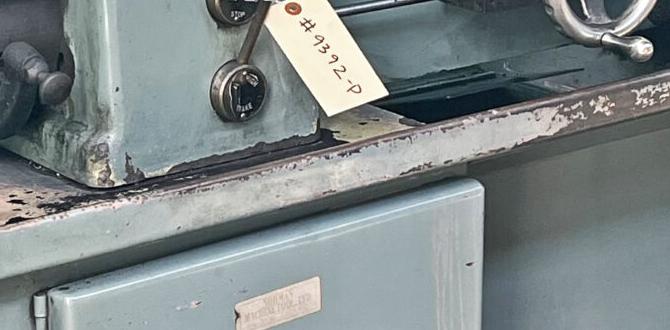Wood lathe tool sharpening jig plans PDF guides offer a clear, step-by-step path to perfectly sharp woodworking tools, ensuring precise cuts and a smoother finish for your projects. Finding or creating the right jig is key to consistent, safe sharpening for hobbyists and pros alike.
Are your wood lathe tools losing their edge? It’s a common frustration for anyone who loves turning wood. Dull tools don’t just make your work harder; they can be downright dangerous, leading to skipped cuts and unpredictable results. The answer often lies in a good sharpening jig designed specifically for wood lathe tools. Many woodworkers find that having clear plans, especially in a convenient PDF format, takes the guesswork out of creating or choosing the perfect jig. This guide will walk you through why a sharpening jig is so important and how downloadable plans can set you up for success, ensuring your tools are always razor-sharp and ready for your next project.
Why Wood Lathe Tool Sharpening is Crucial
Keeping your wood lathe tools sharp is more than just a matter of convenience; it’s fundamental to safety, efficiency, and the quality of your finished work. Think of your tools as an extension of your own skill. A sharp tool glides through wood, leaving a clean, smooth surface. A dull tool, on the other hand, tears and gouges the wood, requiring much more effort to achieve even mediocre results. This extra effort can lead to fatigue, which in turn increases the risk of accidents.
Here’s why sharpness matters:
- Safety First: Sharp tools require less force to cut. This means they are less likely to dig in unexpectedly, catch on the wood, or slip, which are primary causes of injuries when operating a lathe.
- Improved Work Quality: Sharp chisels and gouges produce clean cuts. This translates to less sanding and finishing work later on, saving you valuable time and effort.
- Tool Longevity: When you force dull tools through wood, you’re putting unnecessary stress on the tool’s edge, which can lead to chipping or premature wear. Regular sharpening preserves the life of your tools.
- Efficiency: Sharp tools simply cut faster and more effectively. You’ll spend less time wrestling with the material and more time enjoying the creative process.
The challenge for beginners, and even many experienced woodturners, is achieving that perfect, consistent edge every single time. This is where a dedicated sharpening jig comes into play.
The Role of a Sharpening Jig
Manually freehand sharpening wood lathe tools can be incredibly difficult. Holding a gouge or chisel at the precise angle required against a grinding wheel or sharpening stone requires a steady hand and a lot of practice. Even then, achieving consistency from one sharpening session to the next is a significant challenge. This is where a sharpening jig becomes an indispensable tool in your workshop.
A sharpening jig is essentially a stable fixture that holds your tool at a predetermined angle while you bring it into contact with your sharpening surface (like a grinding wheel or a sharpening stone). By controlling the angle and the movement of the tool, a jig ensures:
- Consistent Angles: You can set the jig to hold your tool at the optimal angle for its intended use, whether it’s a roughing gouge, a spindle gouge, or a skew chisel.
- Repetitive Results: Each time you use the jig, you’re likely to achieve a similar edge, making it easier to maintain your tools.
- Reduced Risk of Overheating/Burning: Many jigs help maintain a steady contact with the grinding wheel, reducing the chance of overheating and “burning” the tool’s edge—a common problem with freehand sharpening.
- Easier for Beginners: For newcomers to woodturning, a jig drastically lowers the learning curve for tool sharpening, allowing them to focus on their turning skills.
Why Look for Wood Lathe Tool Sharpening Jig Plans PDF?
While many excellent commercial sharpening jigs are available, they can be expensive. For the DIY-minded woodworker or those on a budget, building your own sharpening jig is a rewarding project. This is where “Wood Lathe Tool Sharpening Jig Plans PDF” becomes your search term of choice.
Here’s why plans in PDF format are so beneficial:
- Accessibility: PDFs are universally compatible. You can download them onto almost any device—your computer, tablet, or smartphone.
- Portability: Print the plans out and take them directly to your workshop. You don’t need a screen in your dusty environment.
- Detailed Instructions: Well-written plans will include precise measurements, material lists, and step-by-step assembly instructions, often accompanied by diagrams or photos.
- Cost-Effectiveness: Often, downloadable PDF plans are significantly cheaper than buying a commercial jig, and the materials to build one are usually readily available.
- Customization: With plans, you have a solid foundation, but you can also adapt the design slightly to fit your specific tools or workspace if needed.
- Guaranteed Quality: Reputable plans come from experienced woodworkers or machinists who have designed and tested their jigs, ensuring they work effectively.
Searching for these plans allows you to tap into a wealth of knowledge and craftsmanship from the woodworking community.
Key Features of Effective Sharpening Jig Plans
When you’re browsing for “Wood Lathe Tool Sharpening Jig Plans PDF,” not all plans are created equal. Look for plans that provide clear, actionable information. Here are the essential components you should expect:
Comprehensive Material List
A good set of plans will provide a detailed list of all materials needed, including specific types of wood, metal components (like bolts, nuts, washers), and any hardware. This helps you accurately budget for the project and ensures you don’t miss critical parts during your shopping trip.
Precise Measurements and Dimensions
Accuracy is crucial in jig building. The plans should provide exact measurements for every part. This includes lengths, widths, angles, and hole placements. Vague dimensions will lead to a wobbly, inaccurate jig.
Clear Step-by-Step Assembly Instructions
The assembly process should be broken down into logical, easy-to-follow steps. Each step should describe the action required and, ideally, be accompanied by a visual aid.
Detailed Diagrams and Illustrations
Visuals are incredibly helpful. Diagrams showing how parts fit together, the orientation of components, and the final assembled jig are essential. Think of them as blueprints for your project.
Tool Compatibility Information
Does the jig design accommodate the types of tools you use? Some jigs are versatile, while others are optimized for specific tools like gouges or skew chisels. The plans should ideally indicate what types and sizes of tools the jig is designed for.
Safety Guidelines
While building the jig, and especially when using it, safety is paramount. Reputable plans will often include brief safety tips relevant to the construction and operation of the jig.
Testing and Performance Notes
Plans from experienced makers might include notes on how the jig performs, tips for its use, and perhaps even examples of the results achieved. This adds valuable context.
Types of Wood Lathe Tool Sharpening Jigs (What Plans Might Offer)
The world of wood lathe tool sharpening jigs is diverse. When you look at PDF plans, you might encounter designs for several common types, each with its own strengths:
1. Grinder-Saddle Jigs
These are perhaps the most common type. They typically involve a base or “saddle” that rests on the tool rest of your grinder, allowing the tool to slide back and forth at a consistent angle. Some designs are simple blocks of wood with grooves, while others are more elaborate metal contraptions.
Pros: Generally simple to build, versatile for various tools (gouges, chisels).
Cons: Can require more practice to get the feel for the correct angle pressure.
2. Armature/Pivot Jigs
These jigs often have a pivoting arm that holds the tool. The arm is set at a specific angle and swings against the grinding wheel. They can offer very precise angle control.
Pros: Excellent for achieving very precise and repeatable angles.
Cons: Can be more complex to build, might be less forgiving if not built accurately.
3. Stone-Holding Jigs
While most jigs are for grinding wheels, some plans might be for sharpening systems that use stones. These jigs might hold the stone itself at a consistent angle or guide a tool across a stationary stone.
Pros: Great for those who prefer the feel and coolness of stone sharpening.
Cons: Can be slower than grinding; some designs require dedicated setup.
4. Dedicated Tool Holder Jigs
Some plans focus on jigs for very specific tools, like a jig made solely for sharpening bowl gouges or spindle gouges, ensuring the exact bevel angle is maintained. Others might be for skew chisels.
Pros: Highly optimized for the specific tool.
Cons: Less versatile, you might need multiple jigs for a complete set of tools.
Building Your Own Jig: Essential Tools and Materials
Even with detailed plans, you’ll need a basic set of tools and some common materials to bring your sharpening jig to life. The exact list will depend on the specific plans you choose, but here’s a general idea:
Common Tools You Might Need:
- Measuring Tape and Ruler: For accurate marking.
- Pencil or Marking Knife: For transferring measurements.
- Saw: A handsaw, miter saw, or table saw for cutting wood to size.
- Drill and Drill Bits: For creating holes for bolts and other fasteners. A drill press is ideal for accuracy if available.
- Screwdriver Set or Drill Driver Bits: To install screws.
- Sandpaper: For smoothing edges and surfaces.
- Clamps: To hold pieces securely while assembling.
- Optional: Router, sanding jig, or file for shaping components.
Typical Materials:
- Hardwood: Dense hardwoods like oak, maple, or poplar are excellent choices for jig components as they are durable and stable.
- Plywood: Good quality plywood can also be used for certain parts, especially larger base pieces.
- Bolts, Nuts, and Washers: Standard hardware store items. Ensure you verify the sizes required by your plans. Many jigs use adjustment bolts that allow you to finely tune the angle.
- Metal Rods or Tubes: For sliding mechanisms or pivot points.
- Wood Screws: To join wooden parts.
Finding Reputable Wood Lathe Tool Sharpening Jig Plans PDF – Where to Look
The internet is teeming with resources, but finding reliable, well-designed plans requires a bit of searching. Here are some key places and ways to find them:
Woodworking Forums and Communities
Online forums such as WoodworkingTalk or r/woodworking on Reddit are goldmines. Users often share their own designs, building experiences, and links to plans they’ve used or created. Searching these forums for “sharpening jig plans” can yield fantastic results. Many experienced woodworkers are generous with their knowledge.
Woodworking Blogs and Websites
Many popular woodworking blogs feature their own DIY projects, including tool sharpening jigs. Look for established sites that focus on practical projects for the home workshop. Authors often provide detailed build logs and sometimes even offer free or low-cost PDF plans.
YouTube Channels
While not always providing PDFs directly, many YouTube woodworking channels demonstrate how to build sharpening jigs. Often, in the video description, creators will link to their website where you can download plans, sometimes for free or a small fee. It’s a great way to see the jig in action before you even start building.
Specialized Woodworking Sites
Some websites are dedicated to selling woodworking plans. While many might focus on furniture, you can often find sections dedicated to shop-made jigs and tools. Look for sites that have a strong reputation for quality plans.
Government and Educational Resources
While less common for specific jig plans, educational institutions and government extension offices sometimes provide guides on woodworking basics and shop safety. For example, the Forest Products Laboratory (FPL), part of the U.S. Forest Service, offers research and publications that can provide foundational knowledge, though usually not specific jig plans.
Step-by-Step Example: Building a Simple Grinder-Saddle Jig
To give you a taste of what “Wood Lathe Tool Sharpening Jig Plans PDF” might lead to, let’s outline the general steps for building a basic, yet effective, grinder-saddle jig. This is a common design that relies on simple wood construction.
Materials:
- One piece of hardwood, approximately 6″ x 4″ x 2″ (for the base/saddle)
- One piece of hardwood, approximately 8″ x 3″ x 2″ (for the upright support)
- One sliding fence/guide piece, approximately 6″ x 2″ x 1″
- Two short bolts (e.g., 1/4″ x 2″) with nuts and washers
- One longer bolt (e.g., 1/4″ x 3″) with a knob or wingnut (for adjusting tool angle)
- Wood screws
Tools:
- Saw
- Drill and drill bits
- Screwdriver
- Measuring tape, pencil
- Sandpaper
Steps:
- Prepare the Base: Take the 6″ x 4″ x 2″ piece. This will be your saddle that slides on the tool rest. You may need to trim its thickness slightly so it fits snugly but slides freely on your grinder’s tool rest. Many plans might suggest using a jig to ensure a perfect fit.
- Attach the Upright: Center the 8″ x 3″ x 2″ piece on top of the base piece, perpendicular to it. Secure it firmly with wood screws. Ensure it’s square and stable. This upright will hold the sliding fence.
- Create the Sliding Fence: Take the sliding fence piece. You’ll need to create a groove or slot in it that will hold your tool (e.g., a gouge). The width of this slot determines the diameter of the tool it can hold. This is often done with a table saw or a router.
- Mount the Sliding Fence: Position the sliding fence against the upright support. It needs to be able to slide up and down. You can achieve this by drilling holes through both the upright and the sliding fence, then using the two short bolts as guides. Don’t overtighten; the fence needs to move. You can add washers to help it slide smoothly.
- Create the Angle Adjustment: Drill a hole through the front of the upright support at an angle. This hole should allow the longer bolt to pass through and engage with the sliding fence. The angle of this hole will be your primary tool sharpening angle. Some plans incorporate a more sophisticated mechanism for angle adjustment, like a pivot with locking nuts, but a simple bolt can work for beginners.
- Install the Angle Adjustment Bolt: Insert the long bolt through the drilled hole. When you tighten this bolt (ideally into a threaded insert or a nut secured in the sliding fence), it will lock the sliding fence at a specific angle. Using a knob or wingnut makes adjustments easier without needing a wrench.
- Refine and Smooth: Sand all edges smooth to prevent snagging. Ensure all parts move freely but are stable when locked. You might want to add a “stop” to prevent the sliding fence from coming completely off the upright.
- Test It: Place the jig on your grinder’s tool rest and test its stability. Try sliding a tool into the fence at your desired angle.
This is a simplified example. A good PDF plan will provide exact dimensions, optimal angles, and potentially more refined methods of attachment and adjustment. For instance, a more advanced jig might use metal T-slots or precise pivot points for better angle retention.
Using Your Sharpening Jig Safely and Effectively
Building the jig is only half the battle. Knowing how to use it correctly is crucial for both your safety and achieving sharp tools. Always refer to the specific instructions that came with your PDF plans, but here are general best practices:
Before You Start
- Read the Plans: Thoroughly understand the jig’s design and how it operates.
- Inspect Your Grinder: Ensure your grinder’s tool rest is securely in place and at the correct height for your jig. Make sure the grinding wheel is in good condition and securely mounted.
- Wear Safety Gear: Always wear safety glasses or a face shield. Hearing protection is also recommended.
- Clear the Area: Remove any clutter from around your

